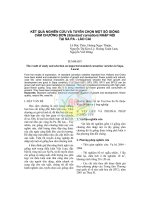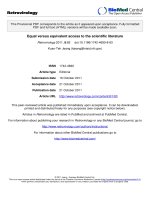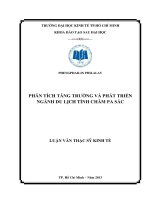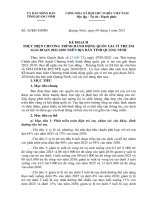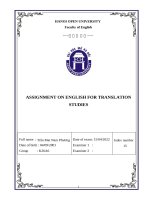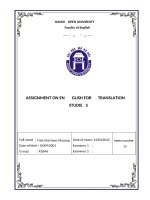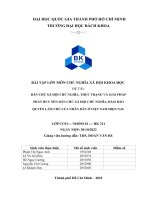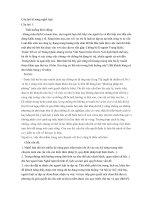5064-Asm1.Docx Pa.pdf
Bạn đang xem bản rút gọn của tài liệu. Xem và tải ngay bản đầy đủ của tài liệu tại đây (816.31 KB, 32 trang )
ASSIGNMENT 1 FRONT SHEET
Qualification
BTEC Level 5 HND Diploma in Business
Unit number and title
Unit 20 Organizational Behavior
Submission date
15/06/2023
Date Received 1st submission
Re-submission Date
Date Received 2nd submission
Student Name
Nguyễn Thị Mai Anh
Student ID
GBH211425
Class
GBH1114
Assessor name
Hoàng Phương Anh
Student declaration
I certify that the assignment submission is entirely my own work and I fully understand the consequences of plagiarism. I understand that
making a false declaration is a form of malpractice.
Student’s signature
Mai Anh
Grading
P1
P2
P3
P4
P5
M1
1
M2
M3
D1
D2
❒ Summative Feedback:
Grade:
❒ Resubmission Feedback:
Assessor Signature:
Date:
Internal Verifier’s Comments:
Signature & Date:
2
Table of Contents
Introduction
4
I. Our team activity and its aims
4
1. Introduction of our team activity
4
2. Aims and purposes
5
3. Activity contents
6
4. Team members’ roles
9
5. Timeframe
10
II. My personality test results and their impacts in terms of management approaches and
contribution to teamwork effectiveness
1. Personality test results
12
12
a. MBTI Test
12
b. 5 Traits Test
13
c. Perception to team’s responsibility
14
2. Their impacts in terms of management approaches and contribution to teamwork
effectiveness:
a. Strengths and weaknesses of personality
16
16
b. Their impacts in terms of management approaches and contribution to teamwork
effectiveness
17
c. Recommendations
18
III. Facilitators and obstacles we faced and motivational theories team leader applied
1. Facilitators and obstacles we faced during the group work
19
19
a. Facilitators
19
b. Obstacles
20
2. Motivational theories
21
3. Solutions to adapt personal perspectives
23
IV. Proposition to set up a company and the improvement for effectiveness in terms of
technology application and team development
24
1. About the company
24
2. Improvement for effectiveness
25
a. Technology application
25
b. Team development
26
V. Conclusion
29
References
30
3
Introduction
This report provides a comprehensive overview of a five-member team that collaborated on the
Happy Charity Day volunteer project. Specific activities for fundraising and charity at the National
Children's Hospital will be mentioned. Then, the report examines the outcomes of personality
assessments, focusing on how the characteristics of individual team members contribute to their
management approaches and collaboration. Identified are the facilitators who positively influence
the team's progress as well as the obstacles they succeed during the activity's execution. The
motivational theories employed by the team leader to keep the members engaged and motivated will
be discussed. In addition, the report proposes the establishment of a company, recommending the
incorporation of technology and strategies for team development to increase efficiency. The report
provides valuable insights into the team's dynamics, achievements, and areas for development by
analyzing these key ideas.
I.
Our team activity and its aims
1. Introduction of our team activity
According to Mr. Tran Minh Dien - the National Children's hospital's director, there are currently
1992 pediatric patients receiving inpatient treatment, with specific needs such as mechanical
ventilation (116 patients), oxygen support (165 patients), and surgical interventions (102 patients).
The majority of these children come from remote provinces, suffer from serious illnesses, and face
various economic hardships (National Children's Hospital, 2023). After conducting a survey and
holding discussions, our group has decided to organize "Happy Charity Day" to support the
children at the National Children's Hospital.
"Happy Charity Day" was started by students in GBH1114 to raise money for the National
Children's Hospital. The primary objective is to alleviate the burden these patients and their
families encounter by providing them with support and encouragement throughout their medical
journey. The group utilized social networking platforms such as Facebook between May 18, 2023,
and May 25, 2023, to generate funds. In addition, we organized a live fundraiser on the University
of Greenwich Hanoi campus on Thursday morning from 9:00 a.m. to 12:30 p.m.
4
Poster “Happy Charity Day”
2. Aims and purposes
"Happy Charity Day" is a fundraiser organized by Group 1 of class GBH1114 to benefit minors
receiving medical care at the National Minors' Hospital. This project's objective is to alleviate the
financial burdens these children and their families confront and provide them with motivation
throughout their treatment journey.
In March 2023, professors, personnel, and students at Greenwich Vietnam's Hanoi campus
contributed a total of 1,882,000 VND to ALIFE - Greenwich Volunteer Club. Our group has
established a goal range of 2.5 million to 3 million VND for donations using the same donation
methods, drawing inspiration from their success.
5
The donation of ALIFE in March (ALIFE, 2023)
To commemorate International Children's Day on June 1st, the group has decided to donate the
funds raised through the "Happy Charity Day" initiative to the National Children's Hospital to assist
the children there. The objective is to ensure that these infants receive the highest quality care and
treatment.
3. Activity contents
Order
Activities
1
Brainstorm ideas and goals for the project
2
Division of work among members
3
Design media publications
4
Create a fanpage "Happy Charity Day" and a bank account
5
Implement promotional activities for the project
6
Prepare offline donation activities in class
7
Implement charity activities at the National Children's Hospital
6
The members of the team have meticulously planned the project's activities to achieve the outlined
objectives. They have defined the goals, assigned tasks to each member, and established a budget.
To facilitate communication about the project's volunteer activities, a social media fan page has
been created. To promote the group's charitable activities, a marketing strategy has been devised
that includes creating posters and disseminating articles on the fanpage. The team has sent emails to
project sponsors in order to optimize contact activities. The group has meticulously planned the
logistical tasks, including the preparation of charity cases and posters. In addition, the team has
organized an offline charity event on the third floor of the Golden Park building at 2 Pham Van
Bach. Donations are accepted via online banking as well as at the locations listed.
Activities on offline donation day
7
Following the successful main event held at the University of Greenwich's 3rd-floor hall, the project
has achieved significant fundraising success, accumulating an impressive total of 6,261,177 VND.
This amount includes 3,091,000 VND in cash donations and 3,170,177 VND transferred
electronically.
Total amount raised
On June 1, 2023, the team visited the Social Affairs Department of the National Children's Hospital
in Hanoi to personally deliver the donated funds to families of pediatric patients who are facing
difficult circumstances. The funds were presented as a small gift on the occasion of International
Children's Day.
8
Give presents for children at National Children’s Hospital
4. Team members’ roles
Role
Member(s)
Leader
Ngoc Tu
Set activity plan, divide tasks among members
Ngoc Tu
Create fanpage, write posts on social media
Mai Anh
Write posts on social media
Linh Chi
Design poster and other media publications
Que Anh
Take photos of the activities
Media
All
Finance
Operation
Logistic
Activities
Share, interact on social media
Ngoc Tu
Receive donations, monitor cash flow
Duc Dat
Analyze timetable, declare offline donation time
Mai Anh
Write script for offline donation
Mai Anh
Write emails to inform about the activities
Que Anh
Send emails to sponsors
All
Offline donation
All
Do charity at the hospital
Que Anh
Prepare the donation box, print posters, etc.
9
5. Timeframe
Order
Time
Activities
Establish a plan and assign roles and responsibilities
1
15/05/2023
+ set clear goals and objectives for the fundraising activity
+ determine the target fundraising amount and create a budget
+ plan to setup the event venue
2
17/05/2023
3
18/05/2023
4
19/05/2023
5
20/05/2023
6
22/05/2023
- Design a poster and other media publications
- Create a bank account to donate
- Create fanpage “Happy Charity Day”
- Develop a marketing strategy for the charity activity
Write an introduction about the project and post on fanpage
Write an introduction about the children at Vietnam National Children’s
Hospital and post on fanpage
Send email to sponsors
- Write a remind post before D-Day
7
24/05/2023
- Write script for offline donation
- Prepare the donation box and poster
- Offline donation
8
25/05/2023
- Take photos
- Write a recap post of offline donation activities
- Collect and tally all funds raised
9
01/06/2023
- Share the final fundraising amount on the fanpage
- Charity at Vietnam Hospital Children’s Hospital
10
15/06/2023
Write a thank you post to express gratitude to all involved in the
fundraising activity
The activities outlined represent a well-structured plan for organizing and executing the "Happy
Charity Day" fundraising event. Each stage is designed to optimize the impact of the fundraising
efforts, from establishing a clear plan and designating roles to creating promotional materials,
developing a marketing strategy, and contacting potential sponsors. A direct fundraising event was
held so people could support the project in person and interact with the project. After totaling the
10
funds raised and distributing them to the pediatric patients at the National Children's Hospital, a
sincere expression of gratitude to everyone who helped make the event successful follows. This
cohesive plan ensures efficient coordination, effective communication, and a significant
fundraising effort.
“Happy Charity Day” fanpage
11
II.
My personality test results and their impacts in terms of management approaches
and contribution to teamwork effectiveness
1. Personality test results
a. MBTI Test
MBTI test result
The ESTJ personality type is one of the sixteen classifications of the Myers-Briggs Type Indicator
(MBTI) and is based on Carl Jung's theory of psychological types. ESTJ stands for Extraversion,
Sensing, Thinking, and Judging.
ESTJs are known for their conventional and grounded nature, relying on past evidence and personal
experience. They prioritize factual information over speculation and trust in what has worked
before. They highly value rules, standards, and maintaining social order, often assuming
leadership roles to help others meet expectations. In the workplace, ESTJs excel as project
managers. They are skilled at setting goals, making decisions, and organizing resources
efficiently. They prioritize productivity and believe that organization is key to achieving success.
ESTJs have a commanding presence and take charge of situations, confident in their ability to
ensure things go as planned. They are task-oriented and prioritize work over leisure. Their
confidence and assertiveness give them an aura of control. When having problems, ESTJs
immediately seek to establish structure and enforce rules. According to Owens (2021), in social
interactions, ESTJs often connect with others through established rituals and routines. They
appreciate following traditions as a way to engage with others in a structured manner.
To summarize, Executives are representatives of tradition and order, utilizing their understanding
of what is right, wrong and socially acceptable to bring families and communities together. People
12
with the executive personality type embrace the virtues of sincerity and devotion. They value their
clear advice and direction, and they gladly take the lead on challenging paths. Executives, who take
pride in bringing people together, frequently serve as community organizers (16 Personalities,
2023).
b. 5 Traits Test
5 Traits test result
The Big Five assessment measures personality scores across five major dimensions: Openness,
Conscientiousness, Extraversion, Agreeableness, and Neuroticism (OCEAN). Each dimension
reflects different aspects of an individual's personality (Darby, 2023).
Openness characterizes a person's inclination to think in abstract and complex ways. Individuals
with low scores in Openness (56%) are not often creative, adventurous, and intellectually curious,
enjoying new experiences and ideas (Cherry, 2023).
Conscientiousness relates to a person's ability to exercise self-discipline and pursue their goals.
High scorers (65%) in Conscientiousness tend to be organized, determined, and capable of
delaying immediate gratification for long-term achievements (Annabelle, 2023).
13
Extraversion pertains to an individual's tendency to seek stimulation from the external world,
particularly through social interactions and attention from others. Extraverts actively (60%) engage
with others to seek friendship, admiration, power, status, excitement, and romantic connections
(Cherry, 2023).
Agreeableness describes a person's inclination to prioritize the needs of others over their own and to
foster cooperation rather than competition. Individuals high in Agreeableness (65%) exhibit
empathy, derive pleasure from helping and caring for others, and tend to be trusting and forgiving
(Annabelle, 2023).
Neuroticism reflects an individual's predisposition to experience negative emotions, such as fear,
sadness, anxiety, guilt, and shame. While everyone experiences these emotions to some extent,
individuals with lower Neuroticism (25%) scores are better equipped to brush off misfortunes
and move forward (Annabelle, 2023).
c. Perception to team’s responsibility
● Personal experience and role
Having experience in a specific field provides the author with a competitive advantage, enabling
them to excel in similar job roles and contribute effectively to their organizations (Thompson,
2021). Based on the author's experience as the Vice president of the volunteer club, ALIFE Greenwich Volunteer Club, the author will have several advantages when in charge of various
responsibilities for the Happy Charity Day volunteer project.
As the vice president of ALIFE - Greenwich Volunteer Club, the author has gained valuable
experience in effectively communicating and engaging with the club's members and followers
through social media platforms. She understands the importance of crafting informative and
compelling posts that capture the attention of the audience and convey the message clearly. Her
experience in promoting volunteer activities and initiatives through social media will enable her to
utilize appropriate language, engaging content, and visual elements to effectively inform and
inspire others about the Happy Charity Day project.
In addition, the author's role of the ALIFE - Greenwich Volunteer Club would have involved regular
communication with club members, volunteers, and external stakeholders via email. This
experience has honed her ability to draft clear, concise, and professional emails to inform and
update recipients about various activities and events. She understands the importance of
providing essential information, highlighting key details. Her experience in email correspondence
14
will allow her to effectively communicate the purpose, goals, and logistics of the Happy Charity
Day project to relevant individuals and organizations.
Additionally, the author may have been involved in organizing fundraising events and
coordinating offline donation activities. This experience has given her insights into the key
components of a successful donation script, such as effectively conveying the mission of the
project, inspiring donors, and providing clear instructions on how to contribute. Her familiarity with
fundraising strategies and her ability to create persuasive and compelling narratives will enable
her to write a script that effectively motivates and engages potential donors during offline donation
activities for the Happy Charity Day project.
Overall, the author's experience as the Vice president of ALIFE - Greenwich Volunteer club
provides her with valuable skills and insights that will be advantageous when fulfilling her
responsibilities of writing posts on social media, writing emails to inform about the activities, and
writing a script for offline donation as part of the Happy Charity Day volunteer project.
● Responsibilities of the team
Moreover, the team's understanding of social dynamics and donor behavior played a crucial role
in shaping their fundraising approach. Initially, the team planned to rely solely on online
donations and a charity event at the 3rd-floor, without considering the importance of promotional
activities. However, based on their observations of student behavior at the University of
Greenwich and the insights gained from the ALIFE club's previous initiatives, they realized that a
more engaging strategy was necessary to attract sponsors. Drawing from their social knowledge, the
team decided to introduce a game during the charity event, where donors who contributed 10,000
VND would receive a game ticket for a chance to win a prize. This adjustment proved effective in
creating an interactive and captivating experience for potential donors.
Regarding the team's plans and objectives, their "Happy Charity Day 2023" project aimed to raise
funds to support children receiving medical treatment at the National Children's Hospital,
alleviating their financial burdens and boosting their spirits during treatment. Initially, the team set
a fundraising goal of 1,000,000 to 2,000,000 VND based on their assessment of donor
contributions from previous charity programs organized by ALIFE. However, they surpassed this
goal by raising 1 million VND in just one day. As a result, the team adjusted their goal to a range
of 2,500,000 to 3,000,000 VND. Ultimately, they exceeded expectations with a total donation
amount of 6,261,177 VND. This showcases the team's adaptability and their commitment to
maximizing their impact by raising more funds to support the children and their families.
15
In summary, the team's achievements in meeting their goals can be attributed not only to the
author's experiences as Vice President of ALIFE - Greenwich Volunteer Club, but also to the
valuable insights gained from team members' observations and interactions. By incorporating
innovative ideas, such as introducing a game at the charity event, the team successfully engaged
supporters and surpassed their fundraising objectives. This highlights their flexibility and
dedication to making a meaningful difference in the lives of those they aim to assist.
2. Their impacts in terms of management approaches and contribution to teamwork
effectiveness:
a. Strengths and weaknesses of personality
● Strengths
As a person with the ESTJ personality type and trait scores of 65% conscientiousness and 65%
agreeableness, Mai Anh possesses several noteworthy strengths. Her exemplary conscientiousness
reflects her organizational skills, determination, and concentration on attaining objectives. The
author is proud of her strong work ethic and ability to plan effectively, adhere to commitments, and
maintain a structured approach to both her professional and personal lives. One of her strengths is
attention to detail, which enables her to produce high-quality work and deliver dependable results.
The author is motivated and disciplined, which enables her to persevere through obstacles and
remain focused on goals, resulting in long-term success.
In addition, her agreeableness score demonstrates her capacity to foster harmonious relationships
and excel in environments that require teamwork. The author exhibist empathy, cooperation, and
consideration for others with a score of 65%. She genuinely cares about the well-being of those
around her, often going the extra mile to offer support and assistance. Understanding and valuing
diverse viewpoints come naturally to her, which contributes to her proficiency in collaboration and
communication. She values maintaining positive relationships and finding fulfillment in assisting
and supporting others. Her cooperative nature and willingness to contribute, compromise, and find
mutually beneficial solutions make her a valuable team member.
By utilizing her organizational skills, determination, empathy, and cooperative nature, she can excel
at tasks requiring attention to detail, planning, collaboration, and fostering positive
relationships with others.
16
● Weaknesses
Besides the above strengths, the author also has limitations that need to be improved.
Her openness score of 56% indicates that she has a moderate preference for conventional thinking
and practicality. While she can adapt to new concepts and experiences to a certain degree, she may
have a slight preference for familiarity and established procedures. This preference may impede
her capacity to completely adopt innovation, creativity, and unconventional solutions, thereby
impeding her adaptability in rapidly shifting situations. To improve this shortcoming, the author
must actively challenge herself to investigate new perspectives, seek out diverse experiences, and
be more receptive to alternative methods of thinking and solving problems.
In addition, her neuroticism score of 25% indicates a reduced propensity for negative emotions
and tension. This can be a virtue in terms of resiliency and retaining equanimity, but it may also
mean that she minimizes or suppresses her negative emotions at times. This could make it
difficult to recognize and resolve personal challenges or to seek support when necessary. To
improve this deficiency, the author must prioritize self-care and emotional health. She must
recognize the significance of her own emotions, engage in self-reflection, and develop strategies to
manage and express them in a healthy manner.
By actively working to increase her receptivity to new ideas and sensitivity to her emotions, she
can improve her adaptability, creativity, and emotional health as a whole.
b. Their impacts in terms of management approaches and contribution to
teamwork effectiveness
As an ESTJ with specific trait scores, the strengths and weaknesses will contribute to the
collaboration efficacy of the Happy Charity Day volunteer project group.
With a conscientiousness score of 65%, the author excels at organization and responsibility
assumption. Her attention to detail ensures that the content of social media posts is well-written,
informative, and in line with the project's objectives. She will concentrate on crafting concise and
engaging messages that resonate with the target audience to effectively promote the charity event.
However, her moderate preference for conventional thought (56% openness) may hinder her
creativity when writing posts. To improve this shortcoming, the author will actively solicit input
from the team during ideation sessions, fostering innovative ideas and disparate points of view to
improve the quality and impact of social media content.
17
As an ESTJ with an agreeableness score of 65%, she values teamwork and collaboration. When
composing the script for offline donation activities, she will ensure that it reflects the project's
aims, and incorporates team input and suggestions. This collaborative approach will contribute to
the creation of a script that effectively conveys the event's purpose and impact. Her attention to
detail will ensure that the emails she sends to inform sponsors about the activities are
well-structured, organized, and contain all necessary information. The author will ensure recipients
have a clear understanding of the event's purpose, and how they can contribute or partake by paying
close attention to detail and accuracy.
Overall, as an ESTJ with the attribute scores, the author contributes to the Happy Charity Day
endeavor with strengths in organization, and collaboration. She will actively encourage creativity
and input from the team to improve the quality and efficacy of the social media posts, donation
scripts, and informative emails. With this strategy, she hopes to contribute to the project's success
and have a positive impact on their community.
c. Recommendations
According to the study conducted by Moutafi et al. (2003), managers who demonstrate discipline
and maintain focus are able to consistently deliver high-quality work and achieve their goals.
Therefore, Mai Anh can take several proactive measures to preserve her advantages and improve
her disadvantages. She should continue to prioritize effective planning, goal-setting, and a
structured approach to her work and personal life to maintain her strengths in conscientiousness
and organizational skills.
According to McGrath et al. (2000), by embracing innovation and unconventional solutions, the
manager can broaden the repertoire of problem-solving techniques and increase the adaptability in
swiftly changing circumstances. Therefore, the author should actively seek out new perspectives
and experiences to improve her adaptability and overcome her minor preference for conventional
thought. She can participate in activities that encourage her to think creatively. This may involve
attending seminars, participating in ideation sessions, or working with individuals from diverse
backgrounds or industries.
According to Wood et al. (2008), by recognizing and expressing the emotions healthily, the manager
can increase her self-awareness and manage personal challenges more effectively. Therefore, the
author should prioritize her emotional well-being to address her decreased propensity for negative
emotions and tension. This may include engaging in activities that promote relaxation, such as
mindfulness exercises, meditation, or pastimes that bring her happiness and satisfaction. She should
18
also establish a network of dependable individuals with whom she can freely discuss her concerns
and seek advice.
Mai Anh should continue to prioritize organization, determination, and collaboration to maintain
her strengths. To improve her disadvantages, she must actively seek out new viewpoints,
challenge conventional thought, and prioritize her emotional health. She can further develop her
strengths and become more adaptable, creative, and emotionally resilient by taking these measures.
III.
Facilitators and obstacles we faced and motivational theories team leader applied
1. Facilitators and obstacles we faced during the group work
a. Facilitators
Multiple facilitators on the project team play a crucial role in propelling the project forward. The
team members share strong connections and have worked and studied together in the past on other
subjects and initiatives. This existing familiarity and camaraderie create a cohesive and
collaborative team dynamic, allowing for effective communication and cooperation throughout the
endeavor.
Each team member offers unique experiences and skills that contribute to the success of the
endeavor. With his prior experience in volunteer organizations and project leadership, Ngoc Tu
excels at planning activities, delegating tasks, managing social media, and handling finances,
thereby ensuring efficient project management and openness.
Mai Anh's participation in ALIFE - Greenwich Volunteer Club has equipped her with invaluable
knowledge regarding the management of volunteer activities. She is an effective communicator and
organizer due to her ability to compose social media posts, write donation templates, and
communicate project updates via email.
Linh Chi's design ability makes her an ideal candidate for designing visually attractive posters and
media materials. Her inventiveness, meticulousness, and aesthetic sensibility aid in communicating
the project's message and attracting attention.
Que Anh's understanding of volunteer organizations and proactive approach in suggesting the
offline donation location demonstrate her dedication and comprehension of the project's objectives.
Her photography abilities and organizational skills in managing logistics contribute to the project's
successful execution.
19
For analyzing schedules and coordinating offline donation activities, Duc Dat's problem-solving and
collaboration skills are invaluable. His analytical mindset, attention to detail, and aptitude for
navigating complex situations guarantee efficient scheduling and coordination.
In addition, external facilitators, such as students, instructors, and acquaintances, play a supportive
role by raising awareness, providing direction, and making donations. Their support increases the
visibility of the initiative and fosters a sense of community and shared responsibility.
Overall, the facilitators within the team and the assistance from external sources contribute
positively to the success and advancement of the project.
b. Obstacles
During the executions, the group encountered a number of obstacles that posed difficulties in
completing the project. As the project is conducted during the summer, the weather is one of the
main factors affecting its progress. High temperatures make it difficult to engage in outdoor
activities such as purchasing items, printing posters, and going to the hospital. Extreme
temperatures can also have a negative effect on the health of group members, lowering their energy
levels and overall productivity.
Moreover, the distance between the group members presents a further disadvantage, especially
during inclement weather. The fact that members are far apart will cause difficulties in moving and
makes in-person team meetings difficult. The team's ability to effectively coordinate and collaborate
may be compromised, which may result in delays and inefficiencies during project execution. As a
result, the group had to switch to online meetings. While these platforms offer convenience and
adaptability, they also limit the level of team interaction. It is possible for the signal to be lost
during communication, which could result in misunderstandings and decreased work
effectiveness.
In addition, the new member (Nguyen Khac Duong) presents difficulties when he is unable to
complete his allotted tasks, causing the other team members to assume additional responsibilities.
This situation may make it challenging to maintain efficiency and meet project deadlines. To ensure
the progress of the project, the team members may be required to complete incomplete tasks,
which may increase their burden and have a negative influence on their performance and work-life
balance. To resolve this issue, team members can provide Duong with support, guidance, and
instruction to enable them to surmount any obstacles they may encounter. Additionally,
20
redistributing tasks or seeking assistance from other team members who can take on additional
responsibilities can help alleviate the burden on the rest of the team.
Overall, bad weather, a distance from one another, and the new member is unable to complete his
allotted tasks all interfered with the group's ability to complete the project.
2. Motivational theories
Maslow motivational theories
Physiological needs: By opting for online meetings as a mode of communication, the team has
considered the physiological requirements of its members. The aforementioned resolution facilitates
the participation of team members regardless of their geographic locations, thereby removing the
obstacles posed by distance. In addition, the team meticulously plans project endeavors
according to the availability of each member, ensuring their full participation and contribution.
Specifically, they prefer to provide and complete duties individually, as well as communicate via
messaging, as they view continuous meetings as a waste of time. Taking into consideration the
potential consequences of inclement weather, the team strategically organizes their charitable
engagements and other events. To avoid the recent calamitous weather, they organize charity events,
make donations, and conduct other activities in optimal locations such as universities and hospitals.
This is done to ensure that the members can participate in a conducive and comfortable environment
(Spector, 2021). During said activities, the team also caters to the physiological requirements of its
members by providing sustenance and refreshments.
21
Safety needs: In order to meet the safety needs of its team members, the Happy Charity Day project
team chooses secure locations, such as schools and hospitals, for their charitable efforts. According
to Maslow's (1954) research, these sites are renowned for their adherence to safety protocols and
use of advanced security protocols. The constant presence of security personnel and the
implementation of comprehensive safety procedures significantly reduce the likelihood of
safety-related incidents involving team members. The team places a high priority on participant
safety by avoiding locations where safety cannot be guaranteed, such as sites associated with
homeless charities. Another group in the class decided to provide free meals to the homeless in the
park, which resulted in an unexpected situation. People began chaotically and inhumanely stealing
food, water, and all other items from the charity organization. This poses a significant hazard to the
charity organization's members. This is the reason why Ngoc Tu's organization chooses to perform
charitable work in a secure, organized hospital.
Belongingness and love needs: The team strives to foster a sense of belonging and affection
among its members by fostering collaborative efforts and mutual support. Team members
collaborate to complete project responsibilities. In addition, they provide substantial life support
for one another, share daily stories, and frequently organize extracurricular activities, such as meals,
movies, etc., outside of study and work hours. According to Maslow's (1954) theory, fostering
strong interpersonal relationships and collaborative efforts among team members as a means of
achieving project objectives is encouraged. Prioritizing the formation of close relationships fosters
affection and camaraderie among team members, resulting in a unified entity that is committed to
the project's collective goals (Spector, 2021).
Esteem needs: During decision-making processes, the team accords significance to the opinions of
each team member to prioritize the satisfaction of esteem requirements. Each member of the team
is responsible for determining all aspects of their duties. In addition, they contribute equally to team
discussions regarding ideas and decisions. Moreover, individuals are assigned specific benchmarks
to evaluate their performance in charitable fundraising endeavors, ranging from 500,000 to
1,000,000 VND per member, and commendation and recognition are given for exceeding these
benchmarks. According to Grawitch et al. (2017), recognizing team members can increase their
self-esteem and perception of team accomplishment.
Self-actualization: The team promotes self-actualization by providing opportunities for personal
development and growth. For example, Linh Chi, the project's primary designer, is encouraged to
expand her design skills, which would enable her to improve and refine her proficiency. As a team
22
leader, Ngoc Tu has opportunities to develop his skills and experiences in preparation for his next
professional endeavor. Additionally, the same pattern is observed in the cases of other team
members. This experience exposes him to novel challenges and promotes his personal development
by allowing him to acquire new perspectives and skills (Maslow, 1954).
3. Solutions to adapt personal perspectives
According to Herzberg et al. (1959), Herzberg's Two-Factor theory indicated that both intrinsic
and extrinsic factors of motivation are important in terms of enhancing work motivation,
especially focusing on job satisfaction and dissatisfaction. As a result, the team can incorporate
Herzberg's theory by addressing the limitations of Maslow's theory and tackle the obstacles
encountered during the "Happy Charity Day 2023" project from multiple perspectives. This broader
perspective allows the team to address a wider range of motivating factors and overcome challenges.
According to Herzberg et al. (1959), Herzberg identified specific factors associated with job
satisfaction (motivators) and those associated with job dissatisfaction (hygiene factors),
providing a more objective and measurable framework for understanding motivation. In contrast to
Maslow's hierarchical structure of needs, which implies a sequential fulfillment of needs, Herzberg's
theory acknowledges that motivation and satisfaction are influenced by distinct sets of factors and
are not solely dependent on the satisfaction of lower-level needs. This approach suggests that
addressing hygiene factors, such as improving working conditions, can prevent dissatisfaction,
while motivators like offering growth opportunities and recognition can increase motivation and
satisfaction. By simultaneously addressing both hygiene factors and motivators, the team can create
a work environment that caters to the changing needs of team members and promotes their
well-being.
According to Hofstede (1984), Maslow's theory has been criticized for its cultural and individual
bias, as it was developed based on a limited sample and may not be universally applicable. In
contrast, Herzberg's theory acknowledges the significance of individual and cultural differences.
Herzberg's research demonstrated that the factors contributing to job satisfaction and dissatisfaction
were consistent across cultures, indicating a broader applicability. To understand the unique
requirements and preferences of team members, the team can conduct individual assessments or
surveys, allowing them to adapt their strategies and foster motivation and job satisfaction for each
member (Locke, 1976).
23
By integrating Herzberg's Two-Factor Theory alongside Maslow's theory, the team can develop a
more comprehensive understanding of motivation and address the diverse needs of team members,
ultimately enhancing their collaboration and performance in achieving project goals.
IV.
Proposition to set up a company and the improvement for effectiveness in terms of
technology application and team development
1. About the company
The Bright Horizons Foundation is a non-governmental organization (NGO) that focuses on
closing the educational gap and empowering impoverished children living in rural areas. Their
mission is to provide high-quality education and equal opportunities for all children, regardless
of their family's income. The foundation aims to address the specific challenges faced by
low-income children aged 6 to 16 in America rural regions by offering scholarships, educational
materials, infrastructure support, and other necessary resources. Recognizing the importance of a
holistic approach to child development, the Bright Horizons Foundation also addresses healthcare,
nutrition, and overall well-being.
Ngoc Tu is the director of the Bright Horizons Foundation, responsible for setting the
organization's vision, mission, and goals. He develops activity plans and strategies to empower
underprivileged children, allocates tasks among team members, ensures smooth coordination, and
provides guidance and support to drive the organization forward.
Duc Dat is the head of the Administration Department. He plays a crucial role in analyzing
schedules for activities and events. He collaborates with other departments to optimize operational
processes and contribute to the successful implementation of the foundation's initiatives.
Linh Chi is the head of the Design Department. She brings creativity and visual appeal to the
foundation's materials, designing visually captivating posters, banners, and other promotional
materials. Linh Chi ensures the foundation's visual identity is consistent and impactful,
collaborating with other departments to meet the design needs effectively.
Mai Anh is the head of the Communications Department. She manages and updates the
organization's social media platforms, creating engaging and informative content for posts and
articles. Mai Anh collaborates with other departments to gather stories and content that effectively
communicate the foundation's mission and impact.
24
Que Anh is the head of the Operation Department. She organizes and coordinates logistical
aspects of the foundation's activities, including printing materials, and ensuring necessary supplies
are available. Que Anh collaborates with other departments to provide logistical support for events,
ensuring smooth operations.
Each member of the Bright Horizons Foundation contributes their skills and expertise in their
respective departments, working together to empower underprivileged children. With effective
leadership, streamlined operations, captivating design, impactful media presence, and efficient
logistics, the foundation aims to make a positive difference in the lives of the children they serve.
2. Improvement for effectiveness
a. Technology application
The project team has applied technology in various aspects of their work. Since the team consists
of members from different regions, face-to-face meetings are challenging. Using online platforms
would be a good choice for the team. Online platforms such as Zoom and Google Meet offer
numerous benefits for online activities, including facilitating remote communication, enabling
real-time collaboration, and providing a seamless virtual meeting experience (Andrew, 2019).
Therefore, they utilize social networking apps such as Zoom, Google Meet, Zalo, Facebook, and
Messenger for group communication. They schedule meetings through chat messages or voting via
Zalo and Messenger and then set up the meetings on platforms like Zoom or Google Meet. These
apps remind project team members to join the meetings on time. This approach allows for effective
communication and collaboration without the need for direct meetings. It also saves travel time,
expenses, and other associated services. Team members have the flexibility to work from home and
manage their time efficiently to address tasks promptly.
Utilizing Google Spreadsheets and Google Docs can be extremely beneficial for remote
collaboration, as they allow for seamless collaboration, efficient document administration,
real-time revision, and information sharing (Andrew, 2019). These online tools provide a centralized
platform where team members can simultaneously create, revise, and share documents, regardless
of location. Multiple team members can work concurrently on the same document, make
suggestions, leave comments, and track changes in real time (Evonence, 2023). Google
Spreadsheets and Google Docs also feature version control, allowing team members to view the
revision history and access the most recent document versions (Sudrajat, 2019). In addition, the
integration of these tools with other Google Workspace applications, such as Gmail and Google
25
